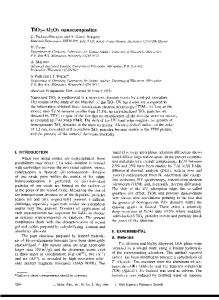TiO 2 /GO nanocomposites: synthesis, characterization, and DSSC application
- PDF / 3,574,953 Bytes
- 21 Pages / 439.37 x 666.142 pts Page_size
- 34 Downloads / 346 Views
TiO2 /GO nanocomposites: synthesis, characterization, and DSSC application Ghasem Habibi Jetani, Mohammad Bagher Rahmania Faculty of Physics, Shahrood University of Technology, 3619995161 Shahrood, Iran Received: 10 June 2020 / Accepted: 1 September 2020 © Società Italiana di Fisica and Springer-Verlag GmbH Germany, part of Springer Nature 2020
Abstract In this investigation, titanium dioxide and TiO2 /graphene oxide nanocomposites were synthesized and coated on FTO glass using the doctor blade method to act as a photoanode in the fabricated dye-sensitized solar cells. X-ray diffraction pattern analysis, Raman spectroscopy, and FTIR confirmed the presence of GO in TiO2 /GO nanocomposites. XRD peaks of the TiO2 sample were indexed to the tetragonal rutile structure; however, some weak peaks were also assigned to the anatase phase. In addition, the amount of GO in the composite caused an increase in current density from 10.18 mAcm−2 in the fabricated cell using pure TiO2 to 10.79 mAcm−2 in the cell fabricated using 0.001 wt% GO in TiO2 /GO nanocomposite. The obtained results give insights into the role of GO in the enhancement of the DSSC device’s performance and present a simple method for the synthesis of novel photoanodes.
1 Introduction Titanium dioxide (TiO2 ) is one of the most promising metal oxides because it has motivating characteristics including n-type semiconducting properties, high optical transmittance in the visible range due to its wide energy bandgap, non-toxicity, abundance, simple synthesis, high chemical, and thermal stabilities, [1–3]. It has been widely used in different applications such as photovoltaics, photocatalysis, gas sensors, and self-cleaning windows [1, 4]. Photovoltaic cell, which convert the incident light into electricity, is one of the promising plans for renewable or green energies. Dye-sensitized solar cell (DSSC) devices are the third generation of photovoltaic cells [5]. A DSSC device is composed of a dye, which produces electron–hole (e–h) pairs by absorbing the incident light, impregnated in a mesoporous TiO2 as a photoanode on a transparent conducting oxide (TCO) which acts as a current collector, a thin Pt catalyst coated on TCO at the other side as a counter electrode, and I − /I 3− electrolyte as redox mediator which restores the dye after each cycle [5, 6]. Between the factors that determine photoconversion efficiency of a DSSC, the electron transport and inhibition of charge recombination, which competes with the transport of photogenerated electrons across the photoanode, in the TiO2 photoanode are of crucial significance. Various strategies have been proposed to increase charge collection and charge transport or suppressing the charge recombination of TiO2 . Doping TiO2 with
a emails: [email protected]; [email protected] (corresponding author)
0123456789().: V,-vol
123
720
Page 2 of 21
Eur. Phys. J. Plus
(2020) 135:720
metal or non-metal ions such as Zn [1, 4, 7] and Sn [8] and adding selected materials such as carbon-based materials (including
Data Loading...











